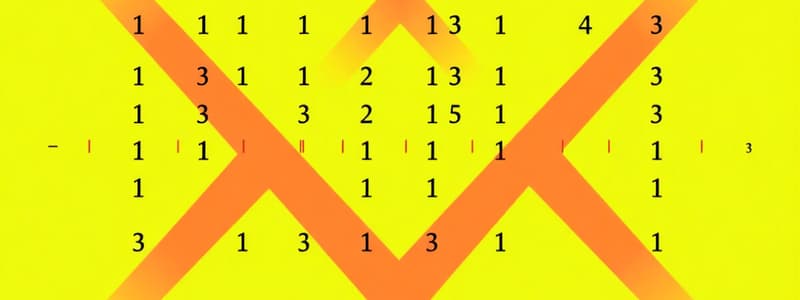Podcast
Questions and Answers
What is considered a state of complete physical, mental, and social well-being?
What is considered a state of complete physical, mental, and social well-being?
- Health (correct)
- Infirmity
- Ill-health
- Disease
Ill-health means being completely free from any negative influence, like poor nutrition.
Ill-health means being completely free from any negative influence, like poor nutrition.
False (B)
Which of the following is an example of a disease?
Which of the following is an example of a disease?
- Heart palpitations
- Stress
- Alzheimer's disease (correct)
- Headaches
Stress-related illness refers to physical symptoms resulting from the body's response to ________.
Stress-related illness refers to physical symptoms resulting from the body's response to ________.
Mental health is simply the absence of mental illness.
Mental health is simply the absence of mental illness.
Which of the following is an example of a mental illness?
Which of the following is an example of a mental illness?
What are the four categories that service users' needs can be classified into?
What are the four categories that service users' needs can be classified into?
Nutrition is an example of an intellectual need.
Nutrition is an example of an intellectual need.
Name one example of an intellectual need.
Name one example of an intellectual need.
Match the need to the corresponding example:
Match the need to the corresponding example:
Which of the following is defined as a sense of belonging, feeling loved, or cared for?
Which of the following is defined as a sense of belonging, feeling loved, or cared for?
Contact with family and friends is an example of an emotional need.
Contact with family and friends is an example of an emotional need.
What do personal relationships fall under?
What do personal relationships fall under?
Relationships, education, employment, income and leisure are five areas impacted by ________.
Relationships, education, employment, income and leisure are five areas impacted by ________.
Long-term illnesses cannot result in job loss.
Long-term illnesses cannot result in job loss.
What could a sick record affect?
What could a sick record affect?
If a family member needs high levels of support, what may family members have to do?
If a family member needs high levels of support, what may family members have to do?
Long-term, income can drastically increase for people with ill-health.
Long-term, income can drastically increase for people with ill-health.
Because of missing classes to look after a sick child, parents may have to miss out on what?
Because of missing classes to look after a sick child, parents may have to miss out on what?
Results in education may suffer as they may lose _______ in school or college due to worrying about their own ill health.
Results in education may suffer as they may lose _______ in school or college due to worrying about their own ill health.
Flashcards
Health
Health
A state of physical, mental, and social well-being, not merely the absence of disease or infirmity.
Ill-health
Ill-health
A state in which an individual is unable to function normally due to the presence of something negative or the absence of something positive.
Disease
Disease
A diagnostic label given to a set of signs and symptoms which are usually long term.
Stress-related illness
Stress-related illness
Signup and view all the flashcards
Mental Health
Mental Health
Signup and view all the flashcards
Mental Illness
Mental Illness
Signup and view all the flashcards
Effects on sick child/adult
Effects on sick child/adult
Signup and view all the flashcards
Effects on family education
Effects on family education
Signup and view all the flashcards
Effect of long term illness on individuals employment.
Effect of long term illness on individuals employment.
Signup and view all the flashcards
Effect of long term illness on family employment
Effect of long term illness on family employment
Signup and view all the flashcards
Less Income
Less Income
Signup and view all the flashcards
Advocacy
Advocacy
Signup and view all the flashcards
Social Needs
Social Needs
Signup and view all the flashcards
Emotional Needs
Emotional Needs
Signup and view all the flashcards
Intellectual Needs
Intellectual Needs
Signup and view all the flashcards
Physical Needs
Physical Needs
Signup and view all the flashcards
Study Notes
Matrices
- Matrices are fundamental mathematical objects that organize numbers, symbols or expressions in a rectangular array and are used in various fields for problem solving.
Definition of a Matrix
- A matrix is a rectangular array of elements arranged in rows and columns, denoted by a capital letter and enclosed in brackets or parentheses.
- $A$ is a matrix with $m$ rows and $n$ columns, where $a_{ij}$ is the element in the $i$-th row and $j$-th column.
- The order of a matrix is $m \times n$ if it has $m$ rows and $n$ columns.
- Each entry in a matrix is called an element.
Types of Matrices
- Row matrix: A matrix with only one row and any number of columns.
- Example: $A = \begin{bmatrix} 1 & 2 & 3 \end{bmatrix}$ is a row matrix of order $1 \times 3$.
- Column matrix: A matrix with only one column and any number of rows.
- Example: $B = \begin{bmatrix} 4 \ 5 \ 6 \end{bmatrix}$ is a column matrix of order $3 \times 1$.
- Square matrix: A matrix with an equal number of rows and columns.
- Example: $C = \begin{bmatrix} 1 & 2 \ 3 & 4 \end{bmatrix}$ is a square matrix of order $2 \times 2$.
- Diagonal matrix: A square matrix where all elements outside the main diagonal are zero.
- Example: $D = \begin{bmatrix} 5 & 0 & 0 \ 0 & -2 & 0 \ 0 & 0 & 3 \end{bmatrix}$ is a diagonal matrix of order $3 \times 3$.
- Scalar matrix: A diagonal matrix in which all the diagonal elements are equal.
- Example: $E = \begin{bmatrix} 7 & 0 \ 0 & 7 \end{bmatrix}$ is a scalar matrix of order $2 \times 2$.
- Identity matrix: A scalar matrix with all diagonal elements equal to 1, denoted as $I_n$ where $n$ is the order.
- Example: $I_2 = \begin{bmatrix} 1 & 0 \ 0 & 1 \end{bmatrix}$ is an identity matrix of order 2.
- Null matrix: A matrix with all elements equal to zero, denoted as $O_{m \times n}$.
- Example: $O_{2 \times 3} = \begin{bmatrix} 0 & 0 & 0 \ 0 & 0 & 0 \end{bmatrix}$ is a null matrix of order $2 \times 3$.
Operations on Matrices
- Addition of Matrices: Two matrices of the same order $m \times n$ can be added together; the sum $C = A + B$ is computed by adding corresponding elements: $c_{ij} = a_{ij} + b_{ij}$.
- Example: $A + B = \begin{bmatrix} 1+5 & 2+6 \ 3+7 & 4+8 \end{bmatrix} = \begin{bmatrix} 6 & 8 \ 10 & 12 \end{bmatrix}$
- Subtraction of Matrices: Two matrices of the same order $m \times n$ can be subtracted; the difference $C = A - B$ is computed by subtracting corresponding elements: $c_{ij} = a_{ij} - b_{ij}$.
- Example: $A - B = \begin{bmatrix} 9-1 & 10-2 \ 11-3 & 12-4 \end{bmatrix} = \begin{bmatrix} 8 & 8 \ 8 & 8 \end{bmatrix}$
- Scalar Multiplication: Multiplying a matrix $A$ of order $m \times n$ by a scalar $k$ results in a new matrix $kA$ where each element is the product of $k$ and the corresponding element of $A$: $kA = [ka_{ij}]$.
- Example: $2A = \begin{bmatrix} 2 \times 1 & 2 \times 2 \ 2 \times 3 & 2 \times 4 \end{bmatrix} = \begin{bmatrix} 2 & 4 \ 6 & 8 \end{bmatrix}$
Properties of Matrix Operations
- Commutative Law: $A + B = B + A$
- Associative Law: $(A + B) + C = A + (B + C)$
- Existence of Additive Identity: $A + O = A = O + A$, where $O$ is a null matrix.
- Existence of Additive Inverse: $A + (-A) = O = (-A) + A$, where $-A$ is the additive inverse of $A$.
Properties of Scalar Multiplication
- Distributive Law over Matrix Addition: $k(A + B) = kA + kB$
- Distributive Law over Scalar Addition: $(k + l)A = kA + lA$
- Associative Law: $k(lA) = (kl)A = l(kA)$
- Multiplicative Identity: $1A = A$
Quantum Mechanics
- Quantum mechanics is a branch of physics that deals with the behavior of matter and energy at the atomic and subatomic levels.
History
- 1900: Max Planck introduces the concept of quantization of energy to explain blackbody radiation.
- 1905: Albert Einstein explains the photoelectric effect by photons.
- 1913: Niels Bohr develops a model of the atom with quantized energy levels.
- 1924: Louis de Broglie proposes that matter has wave-like properties.
- 1925: Werner Heisenberg formulates matrix mechanics.
- 1926: Erwin Schrödinger develops wave mechanics.
- 1927: Werner Heisenberg formulates the uncertainty principle
- 1928: Paul Dirac develops a relativistic theory of quantum mechanics.
Core concepts include
- Quantization - energy, momentum, etc, take on discrete values.
- Wave-particle duality
- Superposition
- Uncertainty Principle - there is a fundamental limit to the accuracy
- Entanglement - entanglement links systems and share the same fate
Key equations within quantum mechanics
- Planck's equation: $E = h\nu$ where E is energy, h is Planck's constant, and $\nu$ is frequency
- de Broglie's equation: $\lambda = \frac{h}{p}$ where $\lambda$ is wavelength, h is Planck's constant, and p is momentum.
- Schrödinger equation: $i\hbar\frac{\partial}{\partial t}\Psi = \hat{H}\Psi$ where $i$ is the imaginary unit, $\hbar$ is the reduced Planck constant, $\Psi$ is the wave function, t is time and $\hat{H}$ is the Hamiltonian operator.
Quantum mechanics has numerous applications
- Laser
- Transistors
- Medical imaging
- Quantum computing
Branches of Quantum Mechanics
- Quantum Field Theory (QFT): Combines quantum mechanics with special relativity
- Quantum Optics: Interactions between light and matter at quantum level
- Quantum Information Theory: Studies storage, processing, and transmission of information using quantum systems
- Quantum Gravity: Theoretical framework that attempts to unify quantum mechanics with general relativity
Challenges facing quantum mechanics
- Interpretation: There is no single, universally accepted interpretation of quantum mechanics.
- Quantum Gravity:
- Scalability: Building large-scale quantum computers is a difficult technological challenge.
Transistor Parameters
- $\beta$ Common-emitter current gain
- $I_S$ Saturation current
- $V_{BE(on)}$ - Base-emitter on voltage
- $V_A$ Early voltage
- $k_n, k_p$: Transconductance parameter in MOSFETs
- $V_t$ Threshold voltage
- $\lambda$: Channel-length modulation parameter
Algorithmic Trading
- Algorithmic trading is combining mathematics, statistics and computer science
- Understanding theoretical foundations of algorithmic trading
- Design implement and backtest trading strategies
- Evaluating performance of trading algorithms
- Manage risk
- Deploy algoritms in a live trading environment
Course Schedule
- Introduction to Algorithmic Trading
- Market Microstructure and Order Book Dynamics
- Backtesting Methodologies and Performance Evaluation
- Risk Management for Algorithmic Trading
- Machine Learning for Trading
- High-Frequency Trading and Latency Optimization
- Portfolio Construction and Optimization
- Execution Strategies and Order Placement
- Regulation and Compliance in Algorithmic Trading
- Advanced Topics in Algorithmic Trading
Assessment
- Homework Assignments: 30%
- Midterm Exam: 30%
- Final Project: 40%
Préparation à l'agrégation de mathématiques
Suites et séries de fonctions
Exercice 1
- Study the convergence of the following series of functions:
- $\sum_{n \geq 1} \frac{x^{n}}{n}, x \in[0,1[$
- $\sum_{n \geq 1} \frac{x^{n}}{n^{2}}, x \in[-1,1]$
- $\sum_{n \geq 1} \frac{\sin (n x)}{n^{2}}, x \in \mathbb{R}$
- $\sum_{n \geq 1} \frac{x}{n\left(1+n x^{2}\right)}, x \in \mathbb{R}$
- $\sum_{n \geq 1} \frac{e^{-n x}}{n}, x \in \mathbb{R}_{+}$
- $\sum_{n \geq 1} x^{n} \sin (n x), x \in]-1,1[$
- $\sum_{n \geq 1} \frac{\cos (n x)}{n^{\alpha}}, x \in \mathbb{R}$ ( $\alpha>1$ fixé)
- $\sum_{n \geq 1} \frac{(-1)^{n}}{x+n}, x \in \mathbb{R}_{+}$
Exercice 2
- Consider the function $\zeta(x)=\sum_{n=1}^{+\infty} \frac{1}{n^{x}}$ for $x>1$
- Show that $\zeta$ is of class $C^{\infty}$ on $] 1,+\infty[$.
- Calculate $\zeta^{\prime}(x)$ for $x>1$.
- Show that $\zeta$ is convex.
Function Convexe
- A function $f: I \rightarrow \mathbb{R}$ is convex on $I$ if for every $x, y \in I$ and every $t \in[0,1]$, we have $f(t x+(1-t) y) \leq t f(x)+(1-t) f(y)$
Singular Value Decomposition (SVD)
- For any matrix $A \in \mathbb{R}^{m \times n}$, there exist orthogonal matrices $U \in \mathbb{R}^{m \times m}$, $U^T U = I$ and $V \in \mathbb{R}^{n \times n}$, $V^T V = I$
Steps in computing SVD
- calculate the SVD
- Find eigenvalues
- $\sigma_i^2$ are eigenvalues of $AA^T$
- Solve for $\lambda^2$
- Find eigenvectors
- Find U
Fourier Transform Properties
- $\mathcal{F} {af(t) + bg(t)} = aF(\omega) + bG(\omega)$
- $\mathcal{F} {f(at)} = \frac{1}{|a|} F(\frac{\omega}{a})$ Compression in time expansion in frequency, Expansion in time compression in frequency
Time Shifting
- $\mathcal{F} {f(t - t_0)} = e^{-j\omega t_0} F(\omega)$
Frequency Shifting
- $\mathcal{F} {e^{j\omega_0 t} f(t)} = F(\omega - \omega_0)$
Convolution
-
$\mathcal{F} {f(t) * g(t)} = F(\omega) G(\omega)$ is defined
-
$\alpha$ and $\beta$ are tautology.
-
$\alpha$ or $\beta$ are lógically equivalent
Leyes de Equivalencia
- Laws to transform logic
Reglas de Inferencia
- Rules to define logic
Studying That Suits You
Use AI to generate personalized quizzes and flashcards to suit your learning preferences.




